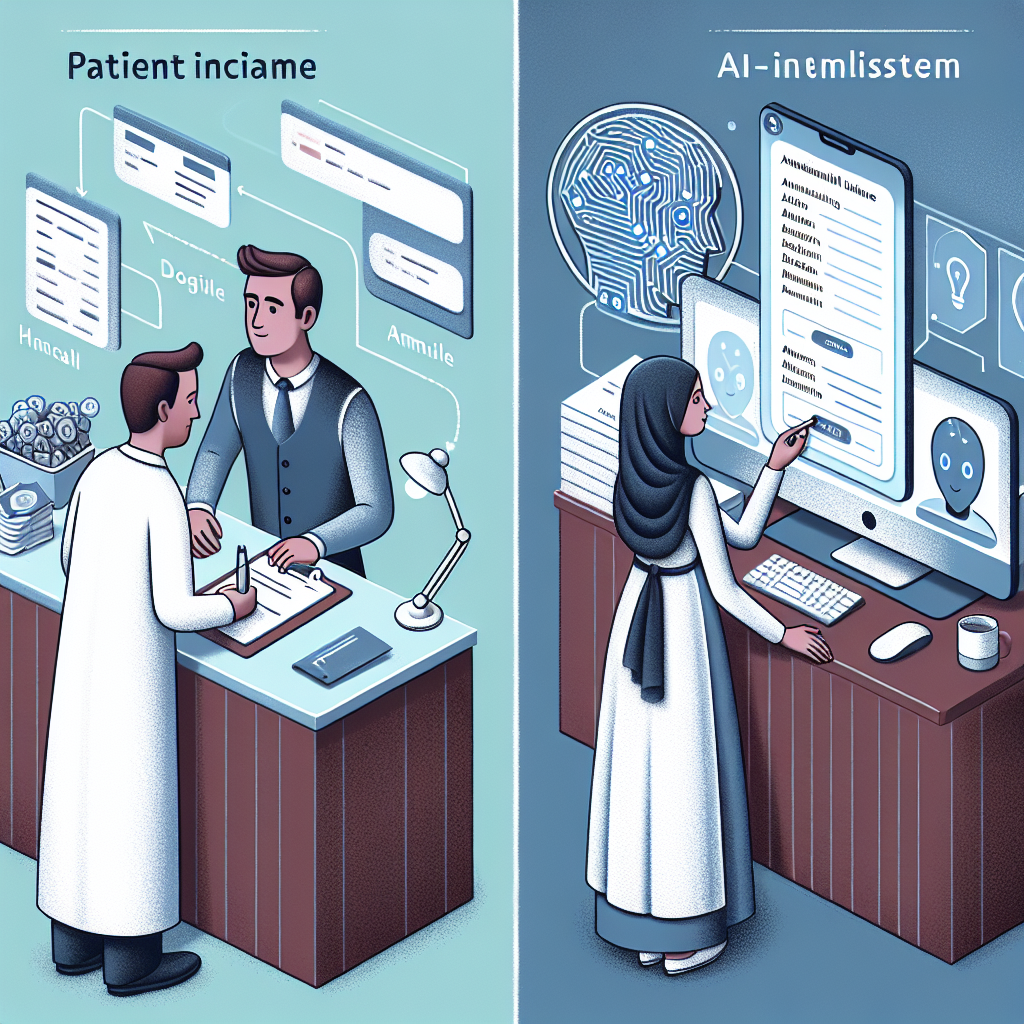Transformative Impact of AI on Patient Intake Processes

The healthcare industry is undergoing a significant transformation, driven by the integration of artificial intelligence (AI) into various operational processes. One of the most promising areas where AI is making a substantial impact is in patient intake processes. This article explores the transformative effects of AI on patient intake, examining how it enhances efficiency, improves patient experience, and reduces administrative burdens. Through detailed analysis and case studies, we will delve into the various facets of AI’s role in revolutionizing patient intake.
1. Streamlining Administrative Tasks
Administrative tasks in healthcare settings are often time-consuming and prone to errors. AI technologies are increasingly being deployed to streamline these tasks, making patient intake more efficient and accurate.
1.1 Automating Data Entry
One of the most labor-intensive aspects of patient intake is data entry. Traditionally, healthcare staff manually input patient information into electronic health records (EHRs), which can lead to errors and delays. AI-powered systems can automate this process by extracting data from various sources, such as insurance cards and previous medical records, and inputting it directly into EHRs.
For example, optical character recognition (OCR) technology, combined with AI algorithms, can accurately capture and digitize patient information from physical documents. This not only reduces the workload for administrative staff but also minimizes the risk of human error.
1.2 Enhancing Scheduling Efficiency
AI can also optimize appointment scheduling by analyzing patterns in patient flow and predicting no-show probabilities. Machine learning algorithms can assess historical data to identify peak times and suggest optimal scheduling slots, ensuring that healthcare providers can maximize their time and resources.
For instance, a study conducted by the Mayo Clinic demonstrated that AI-driven scheduling systems reduced patient wait times by 20% and increased provider utilization by 30%. These improvements not only enhance operational efficiency but also improve patient satisfaction.
1.3 Reducing Paperwork
AI technologies are instrumental in reducing the amount of paperwork involved in patient intake. By digitizing forms and utilizing natural language processing (NLP) to interpret patient responses, AI systems can automatically populate necessary fields in EHRs, eliminating the need for patients to fill out repetitive forms.
This digital transformation not only speeds up the intake process but also ensures that patient data is consistently updated and easily accessible to healthcare providers, facilitating better-informed clinical decisions.
2. Enhancing Patient Experience
AI is not only transforming the administrative side of patient intake but also significantly enhancing the overall patient experience. By providing personalized and efficient services, AI technologies are helping healthcare providers meet the growing expectations of patients.
2.1 Personalized Patient Interactions
AI-driven chatbots and virtual assistants are becoming increasingly popular in healthcare settings, offering patients personalized interactions during the intake process. These AI tools can answer common questions, guide patients through the intake process, and provide real-time updates on appointment status.
For example, Northwell Health implemented an AI-powered chatbot that assists patients in scheduling appointments and answering queries about their healthcare services. This not only improves patient engagement but also frees up staff to focus on more complex tasks.
2.2 Reducing Wait Times
Long wait times are a common source of frustration for patients. AI technologies can help reduce these wait times by optimizing patient flow and resource allocation. Predictive analytics can forecast patient demand and adjust staffing levels accordingly, ensuring that patients are seen promptly.
A case study from a hospital in Boston showed that implementing AI-driven patient flow management systems reduced average wait times by 15 minutes, significantly enhancing the patient experience.
2.3 Improving Accessibility
AI technologies are also improving accessibility for patients with disabilities or language barriers. Speech recognition and translation tools enable seamless communication between patients and healthcare providers, ensuring that all patients receive the care they need without unnecessary obstacles.
For instance, AI-powered translation services can instantly convert spoken language into text, allowing non-English speaking patients to communicate effectively with their healthcare providers. This not only improves patient satisfaction but also ensures that critical information is accurately conveyed.
3. Enhancing Data Security and Privacy
With the increasing digitization of patient data, ensuring data security and privacy has become a top priority for healthcare providers. AI technologies are playing a crucial role in safeguarding sensitive patient information during the intake process.
3.1 Advanced Encryption Techniques
AI-driven encryption techniques are enhancing the security of patient data by automatically encrypting sensitive information as it is collected during the intake process. These advanced encryption methods ensure that patient data is protected from unauthorized access and breaches.
For example, AI algorithms can detect anomalies in data access patterns and trigger alerts in real-time, allowing healthcare providers to respond swiftly to potential security threats.
3.2 Identity Verification
AI technologies are also improving identity verification processes during patient intake. Biometric authentication methods, such as facial recognition and fingerprint scanning, are being integrated into intake systems to ensure that patient identities are accurately verified.
This not only enhances security but also streamlines the intake process by eliminating the need for manual identity checks. Patients can quickly and securely verify their identities, reducing wait times and improving the overall intake experience.
3.3 Compliance with Regulations
AI technologies are helping healthcare providers comply with data protection regulations, such as the Health Insurance Portability and Accountability Act (HIPAA) in the United States. AI systems can automatically monitor and audit data access and usage, ensuring that patient information is handled in accordance with regulatory requirements.
By providing real-time insights into data handling practices, AI technologies enable healthcare providers to maintain compliance and avoid costly penalties associated with data breaches.
4. Improving Data Accuracy and Quality
Accurate and high-quality data is essential for effective patient care. AI technologies are enhancing data accuracy and quality during the intake process, ensuring that healthcare providers have access to reliable information for clinical decision-making.
4.1 Error Detection and Correction
AI algorithms can automatically detect and correct errors in patient data during the intake process. By analyzing patterns and inconsistencies in data entries, AI systems can identify potential errors and prompt staff to review and correct them.
This proactive approach to error detection not only improves data accuracy but also reduces the risk of adverse events resulting from incorrect information.
4.2 Data Standardization
AI technologies are facilitating data standardization by automatically converting patient information into standardized formats. This ensures that data is consistent and compatible across different healthcare systems, enabling seamless data exchange and interoperability.
For example, AI-driven data standardization tools can automatically map patient information to standardized coding systems, such as the International Classification of Diseases (ICD), ensuring that data is accurately categorized and easily accessible.
4.3 Enhancing Data Completeness
AI technologies are also improving data completeness by identifying missing or incomplete information during the intake process. AI systems can prompt patients or staff to provide additional information, ensuring that all necessary data is captured and recorded.
This comprehensive approach to data collection enhances the quality of patient records, enabling healthcare providers to make well-informed clinical decisions and deliver high-quality care.
5. Case Studies and Real-World Applications
To illustrate the transformative impact of AI on patient intake processes, we will explore several case studies and real-world applications that highlight the benefits and challenges of implementing AI technologies in healthcare settings.
5.1 Cleveland Clinic’s AI-Driven Intake System
Cleveland Clinic, a leading healthcare institution, implemented an AI-driven patient intake system to streamline administrative tasks and enhance patient experience. The system utilizes machine learning algorithms to automate data entry, optimize scheduling, and reduce wait times.
Since its implementation, Cleveland Clinic has reported a 25% reduction in administrative workload and a 15% increase in patient satisfaction scores. The AI-driven system has also improved data accuracy, resulting in more reliable patient records and better clinical outcomes.
5.2 Kaiser Permanente’s Virtual Assistant
Kaiser Permanente, one of the largest healthcare providers in the United States, introduced an AI-powered virtual assistant to enhance patient interactions during the intake process. The virtual assistant provides personalized guidance, answers common questions, and assists with appointment scheduling.
The virtual assistant has been well-received by patients, with 80% of users reporting a positive experience. By automating routine interactions, Kaiser Permanente has been able to allocate more resources to complex patient needs, improving overall care quality.
5.3 Challenges and Considerations
While AI technologies offer significant benefits, their implementation in patient intake processes also presents challenges. Healthcare providers must consider factors such as data privacy, integration with existing systems, and staff training when adopting AI solutions.
Ensuring that AI systems are transparent and explainable is also crucial, as patients and providers need to understand how AI-driven decisions are made. Addressing these challenges is essential for maximizing the benefits of AI in patient intake processes.
Conclusion
The transformative impact of AI on patient intake processes is undeniable. By streamlining administrative tasks, enhancing patient experience, improving data security, and ensuring data accuracy, AI technologies are revolutionizing the way healthcare providers manage patient intake. As illustrated by real-world applications and case studies, AI-driven solutions are delivering tangible benefits, from reduced wait times to improved patient satisfaction.
However, the successful implementation of AI in patient intake processes requires careful consideration of challenges such as data privacy and system integration. By addressing these challenges and leveraging the full potential of AI, healthcare providers can enhance operational efficiency, improve patient care, and ultimately transform the healthcare experience for patients and providers alike.





